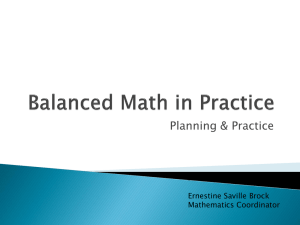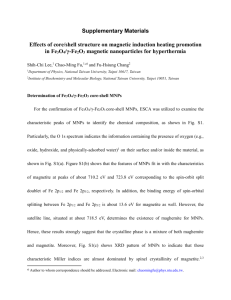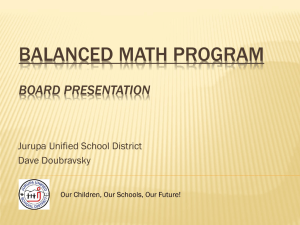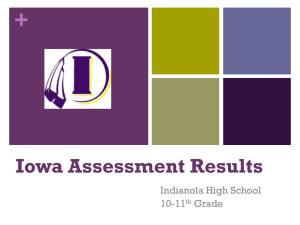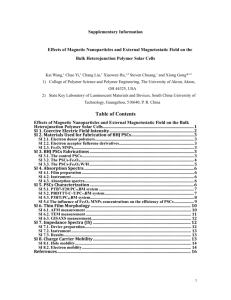APF Presentation (LEAD 2013).
advertisement
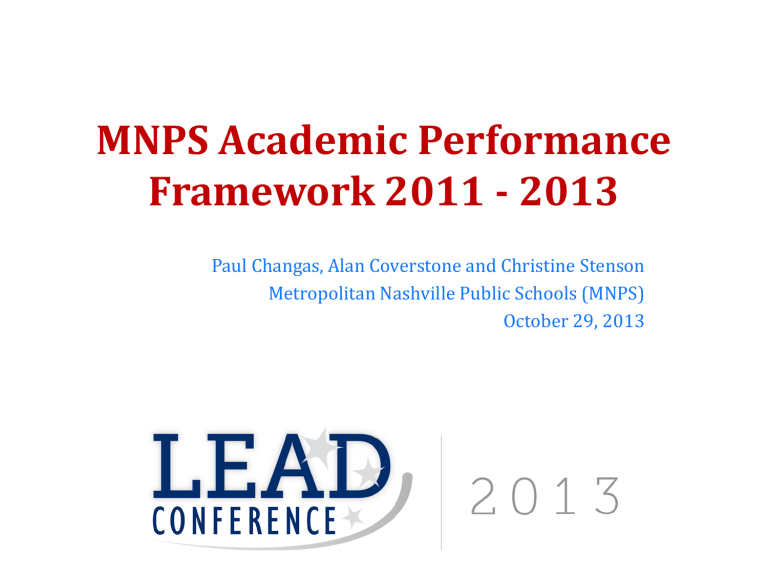
MNPS Academic Performance Framework 2011 - 2013 Paul Changas, Alan Coverstone and Christine Stenson Metropolitan Nashville Public Schools (MNPS) October 29, 2013 The MNPS Framework Presentation Overview • Why the need for a Framework and how it will be used? • Our process in building a Framework • Components of our Framework – indicators and measures • Next steps • Lessons learned that might be helpful to other districts • A framework template for other districts/schools 2 The MNPS Framework Possible Framework Uses • To support efforts to raise student achievement • To support the district’s accountability status • To offer standardized accountability metrics to complement increased school-level autonomy • To inform — but not determine — decisions regarding rewards, supports, and resource allocation for schools • To provide school communities with a transparent set of indicators to understand school performance 3 Why the Need for a Framework? (Why Not Rely on State Accountability Results?) • State absolute accountability system is primarily focused on districts rather than schools • Key school relative accountability results reported every three years rather than annually • State accountability is determined entirely by test scores – there are no school culture measures • There is value in an overall performance index – While a single number cannot tell the whole story, a “bottom line” based upon multiple measures is needed for making decisions – Transparency – outline exactly what measures will be included and how they will be weighted – Manageability – quantity of data can be overwhelming 3 M’s of data use: make it Manageable make it Meaningful make it Matter 4 State Accountability Flowchart 5 The MNPS Framework Indicators and Weighting Academic Progress 50% Attainment & College Readiness 30% Achievement Gap 5% School Culture 15% 6 What Factors Should be Included in School Evaluation? Audience Participation • Participants pair up • Identify 3-5 key factors or indicators that you would include in a school performance system (academic, nonacademic, school culture, etc.) • How would you prioritize these factors (or should they be equally weighted)? • Discuss for 5 minutes and then we will report out 7 The MNPS Framework K-8 Measures and Weighting Performance Scale Minimum & Maximum Key Indicators Academic Progress Measure Weight TVAAS mean NCE gain -5 12 4% 25% TCAP Mean achievement level increase as % of target -40 100 3% 25% 10 90 73% 15% 0 75 78% 15% 0 20 53% 5% 50% 100% 12% 5% NA NA NA 5% Student perceptions - Tripod Favorability (Elementary) 55% 85% Student perceptions - Tripod Favorability (Middle) 45% 75% 0% 5% 0 100 36% 100% Attainment & TCAP% of students scoring proficient College % of students projected from TVAAS to score 21 or above on Readiness ACT Composite Achievement Index based upon gap in TCAP % proficient between Gap subgroups Educator perceptions - TELL TN Survey Favorability School Culture % of Variation due to % Free or Minimum Maximum Reduced Parent perceptions Total Points (weighted composite) 50% Progress 30% Attainment 5% Gap 15% Culture 8 The MNPS Framework High School Measures and Weighting Performance Scale Minimum & Maximum Key Indicators Academic Progress Measure Weight TVAAS mean scale score gain -10 12 3% 25% Mean achievement level increase as % of target -30 100 0% 25% 10 95 78% 10% 0 95 89% 10% 60 100 34% 10% 0 20 58% 5% 50% 100% 0% 5% NA NA NA 5% 40% 75% 35% 5% 0 100 40% 100% Attainment & % of students scoring proficient College % of students scoring 21 or above on ACT Composite Readiness % of students graduating on-time with a regular diploma Achievement Index based upon gap in EOC % proficient between Gap subgroups School Culture % of Variation due to % Free or Minimum Maximum Reduced Educator perceptions - TELL TN Survey Favorability Parent perceptions Student perceptions - Tripod Favorability Total Points (weighted composite) 50% Progress 30% Attainment 5% Gap 15% Culture 9 The MNPS Framework The Academic Performance Scale • Identify key performance measures • Determine the weight of each measure • Determine the performance scale of each measure • Assign performance points to each school based upon position on performance scale 10 The MNPS Framework The Academic Performance Scale Determine the performance scale of each measure Performance Scale Original NCE scale -20 -10 0 -5 Performance Scale Minimum 10 20 12 Scale Maximum 11 The MNPS Framework School Ratings for Growth • Two measures (50% of Total Framework): Value Added and Mean Achievement Level Increase • K-8 subjects: Math, Reading/LA, & Science • HS subjects: Algebra I and II, English I, II, II, & Biology I • Not highly correlated to socioeconomic status 12 The MNPS Framework Mean Achievement Level Increase 2013 2012 School A 90 30% 80 Advanced 10% Proficient Percent of Students 50 Advanced +2% Basic 30% 30 20 30% 32% 80 Advanced 10% 60 50 -2% Advanced 8% Proficient Proficient 20% 24% 32% +2% 70 +2% 40 90 20% Basic 30% School B 12% Proficient 20% 70 60 +2% 2013 2012 100 Percent of Students 100 Basic Basic 24% 30% -4% 40 30 Below Basic 40% Below Basic 20 40% 38% 10 Below Basic Below Basic 44% 10 0 0 Overall 6% Improvement Overall 4% Decline (despite increase in Profic/Adv) 13 The MNPS Framework Mean Achievement Level Increase Goal Example Previous Year Establish Proficiency Increase Goals Based Upon PriorYear Results 100% 90% 80% Advanced (A) 10% Proficient (P) 20% Proficiency Increase Goal Results if Goals Met = 0% x A = 0% Advanced = 20% x P = 4% Percent of Students 50% Proficient 25% 70% 60% 14% Basic (B) 30% = 30% x B = 9% Basic 37% 40% 30% 20% Below Basic (BB) 40% = 40% x BB = 16% 10% Below Basic 24% 0% TOTAL = 0%+4%+9%+16% = 29% 14 The MNPS Framework K-8 Ratings for Achievement & College Readiness • Two measures (30% of Total): Percent Proficient/Advanced and percent of 4th/8th grade students projected to score 21 or higher on the ACT • Percent Proficient/Advanced includes Math (or Algebra I), Reading/LA, & Science • These measures are correlated with socioeconomic status (SES), but schools often break the pattern 15 The MNPS Framework High School Ratings for Achievement & College Readiness • Percent Proficient/Advanced includes Algebra I and II, English I, II, and III, and Biology I • ACT Composite score of 21 or higher is required for the Hope Scholarship and is the average of the subject area college readiness benchmarks. • These measures are correlated with Socioeconomic status, but schools often break the pattern. 16 The MNPS Framework Achievement Gap and Survey Data • • • • • Gap Closure (5% of framework) K-8 subjects: Math, Reading/LA, & Science HS subjects: Algebra I and II, English I, II, II, & Biology I TELL and TRIPOD surveys each count as 5% of framework. Parent survey to be added 17 The MNPS Framework School Rankings Across Measures 18 The MNPS Framework Report Format 19 Charter School Accountability MNPS Commitments 1. Set and hold charter schools accountable to clear, measurable, and attainable academic, financial, and operational performance standards and targets; 2. Close schools that fail to meet performance standards and targets; and 3. Work proactively to identify and establish new, high quality charter schools to serve students who attend schools identified for closure. 20 Outcome-based Performance Management Performance Contracts Accountabilitybased Interventions Consistent Communication (Predictable, enforceable) (Transparent, balanced, comprehensive) (Face validity, engagement) District-Charter Collaboration Compact Focus Groups Scorecard Performance Management, Replication, and Closure (PMRC) Grant Performance Frameworks Policies and Contracts MNPS Research and Assessment Technical Development Balanced Measures Broad Applicability Outcome-based Performance Management How will we use the APF? • Publish Annual School Report Cards • Shape Renewal Process • Shape Recommendations each October 22 Academic Performance Mean Achievement Increase TVAAS TCAP (%PA) Achievement Gap School Culture Measures ACT (21+) Overall Performance (APF) Year by year Renewal Information Projection and Review Level Renewal Application Deadline 5-year Review Year Outcome-based Performance Management How will we use the APF? • Publish Annual School Report Cards • Shape Renewal Process • Shape Recommendations each October 25 3-year status Watch Action Timeline Renewal Review Level NA Simple Renewal 2-years (Updated budget, plans, targets) Full Renewal Review (Full Renewal Application: Renewal Based on Best Interests Standard) Conditional Renewal Review 1-year (Renewal possible but unlikely; significant changes required; may recommend revocation depending on end of year results) Current Cycle No Renewal (May recommend revocation to take affect end of year) Outcome-based Performance Management How will we use the APF? • Publish Annual School Report Cards • Shape Renewal Process • Shape Recommendations each October 27 2013 Status 3-Year Status Recommended Action Excelling Excelling Simple Renewal Review Lead Academy MS Satisfactory Satisfactory None LEAD Academy HS Satisfactory Satisfactory None New Vision Academy Satisfactory Satisfactory None Liberty Collegiate Acad Excelling 2-years None STEM Prep Academy Excelling 2-years None Target 2-years Notice: Revocation in 2014 Likely Excelling 2-years None Insuffic Data 2-years None Cameron College Prep Review 2-years None Knowledge Academy Achieving 1-year None Boy's Prep Target 1-year Notice: Revocation in 2014 Possible Smithson-Craigh Acad Target Target Notice: Revocation in 2014 Likely Smithson-Craigh MS Target Target Closed May 2013 School KIPP Academy Drexel Prep School Nashville Prep School East End Prep What Decisions Would You Be Comfortable With? Audience Participation • Participants pair up • What types of decisions would you be comfortable making with a performance framework for your school(s)? • How many years of data would you need to make these decisions? • What additional information would you want in making decisions about school performance? • Discuss for 5 minutes and then we will report out 29 The MNPS Framework Next Steps • Show expanded data by individual year • Break out mean achievement level increase, TVAAS, and gap calculations by subject • Break out key results by subgroup • Provide professional development on the Framework • Expand documentation • Utilize results in evaluation of initiatives and in identifying schools needing support and resources 30 The MNPS Framework Lessons Learned • Include stakeholders in development • Transparency is critical • Flexibility is essential as standards, assessments and policies change, but the basic principles we value and include in the Framework should hold up over time • Construct the Framework in such a way that the top performance category is within reach of any school, regardless of socioeconomic factors • Performance measures can vary significantly from year to year, so multiple years of data should be utilized in critical decisions • Presentation format is important 31 The MNPS Framework Performance Framework Template Academic Performance Framework Template Measure 1 2 3 4 5 6 7 8 9 10 11 12 13 14 15 16 17 18 19 20 TVAAS Mean Scale Score Gain TCAP % Proficient/Advanced Achievement Gap Index Tripod Survey Favorability TELL TN Survey Favorability TOTAL Scale Scale Reverse Minimum Maximum Scale? -5 10 20 0.55 0.5 0 0 0 0 0 0 0 0 0 0 0 0 0 0 0 12 90 0 0.85 1 100 100 100 100 100 100 100 100 100 100 100 100 100 100 100 No No Yes No No No No No No No No No No No No No No No No No Weight (0-100) School Value 25 15 5 5 5 2.5 48 7.2 0.68 0.77 55 % of Possible Unadjusted Points # of Points 44.1% 47.5% 64.0% 43.3% 54.0% 0.0% 0.0% 0.0% 0.0% 0.0% 0.0% 0.0% 0.0% 0.0% 0.0% 0.0% 0.0% 0.0% 0.0% 0.0% Adjusted# of Points 11.03 7.13 3.20 2.17 2.70 0.00 0.00 0.00 0.00 0.00 0.00 0.00 0.00 0.00 0.00 0.00 0.00 0.00 0.00 0.00 20.05 12.95 5.82 3.94 4.91 0.00 0.00 0.00 0.00 0.00 0.00 0.00 0.00 0.00 0.00 0.00 0.00 0.00 0.00 0.00 26.22 47.67 32 The MNPS Framework Decision-making Process for Each Indicator Each Category of Data Requires the Following Decisions: Unit (e.g. School) Subject Areas Which Measure Years of Data Weighting/ Points Performance Thresholds For Example: Value Added • Should Math, Reading/LA, Science be included? • Should Math, Reading/LA, Science be weighted equally and be combined into a single score? • Should there be discrete score categories (e.g. 1-5), or a linear transformation of the scores such that schools earn from 0 to 100 percent of possible points, or should we use a method that takes into account the fact that most schools’ scores are going to be clustered around the average? • Should the categories be discrete or continuous, do we base them on average growth from 2012 to 2013, or take other years of growth into consideration? If we use two years of data, we get a bigger range of possible scores. • Do we set our evaluation based on what has been average in the school district and the state or based on the growth standard (i.e. zero growth is average)? If we use the growth standard, we may fall behind the state. If we use actual average NCE gains, we will be rating schools on a very different basis than the state does in its report card and on the TVAAS site (for grades 3-8 only). 33 The MNPS Framework Questions? 34
